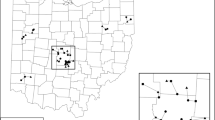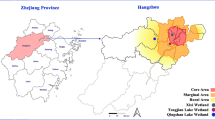Abstract
Exurban areas are expanding throughout the world, yet their effects on local biodiversity remain poorly understood. Wetlands, in particular, face ongoing and substantial threats from exurban development. We predicted that exurbanization would reduce the diversity of wetland amphibian and invertebrate communities and that more spatially aggregated residential development would leave more undisturbed natural land, thereby promoting greater local diversity. Using structural equation models, we tested a series of predictions about the direct and indirect pathways by which exurbanization extent, spatial pattern, and wetland characteristics might affect diversity patterns in 38 wetlands recorded during a growing season. We used redundancy, indicator species, and nested community analyses to evaluate how exurbanization affected species composition. In contrast to expectations, we found higher diversity in exurban wetlands. We also found that housing aggregation did not significantly affect diversity. Exurbanization affected biodiversity indirectly by increasing roads and development, which promoted permanent wetlands with less canopy cover and more aquatic vegetation. These pond characteristics supported greater diversity. However, exurbanization was associated with fewer temporary wetlands and fewer of the species that depend on these habitats. Moreover, the best indicator species for an exurban wetland was the ram’s head snail, a common disease vector in disturbed ponds. Overall, results suggest that exurbanization is homogenizing wetlands into more permanent water bodies. These more permanent, exurban ponds support higher overall animal diversity, but exclude temporary wetland specialists. Conserving the full assemblage of wetland species in expanding exurban regions throughout the world will require protecting and creating temporary wetlands.







Similar content being viewed by others
References
Almeida-Neto M, Guimarães P, Guimarães PR, Loyola RD, Ulrich W (2008) A consistent metric for nestedness analysis in ecological systems: reconciling concept and measurement. Oikos 117:1227–1239. https://doi.org/10.1111/j.0030-1299.2008.16644.x
Altig R (1970) A key to the tadpoles of the continental United States and Canada. Herpetologica 26:180–207
Baldwin R, Calhoun A, DeMaynadier P (2006) The significance of hydroperiod and stand maturity for pool-breeding amphibians in forested landscapes. Can J Zool 84:1604–1615
Barton K (2016) MuMIn: Multi-Model Inference
Berube A, Singer A, Watson J, Frey W (2006) Finding exurbia: America’s Fast-Growing Communities at the Metropolitan Fringe Washington. The Brookings Institution, Living Cities Census Series, DC
Brady SJ, Flather CH (1994) Changes in wetlands on nonfederal rural land of the conterminous United States from 1982 to 1987. Environ Manage 18:693–705. https://doi.org/10.1007/BF02394634
Brown DG, Johnson KM, Loveland TR, Theobald DM (2005) Rural land-use trends in the conterminous United States, 1950–2000. Ecol Appl 15:1851–1863
Burnham KP, Anderson DR (2002) Model selection and multimodel inference: a practical information-theoretic approach, 2nd edn. Springer, New York
Cáceres MD, Legendre P (2009) Associations between species and groups of sites: indices and statistical inference. Ecology 90:3566–3574
Chazdon RL, Colwell RK, Denslow JS, Guariguata MR (1998) Statistical methods for estimating species richness of woody regeneration in primary and secondary rain forests of NE Costa Rica. In: Dallmeier F, Comiskey JA (eds) Forest biodiversity research, monitoring and modeling: Conceptual background and Old World case studies. Parthenon Publishing, Paris, pp 285–309
Collins SJ, Russell RW (2009) Toxicity of road salt to Nova Scotia amphibians. Environ Pollut 157:320–324
Colwell RK (2013) EstimateS: Statistical estimation of species richness and shared species from samples. Version 9, User’s Guide and application published at: http://purl.oclc.org/estimates. Accessed 1 Feb 2014
Colwell RK, Coddington JA (1994) Estimating terrestrial biodiversity through extrapolation. Philosophical Transactions of the Royal Society of London. Series B Biol Sci 345:101–118
Conrad K, Willson K, Harvey I, Thomas C, Sherratt T (1999) Dispersal characteristics of seven odonate species in an agricultural landscape. Ecography 22:524–531
Core Team R (2015) R: A language and environment for statistical computing. R Foundation for Statistical Computing, Vienna
Costanza R et al (1997) The value of the world’s ecosystem services and natural capital. Nature 387:253–260
Dahl TE (1990) Wetlands losses in the United States, 1780’s to 1980’s. Report to the Congress. U.S. Department of the Interior, Fish and Wildlife Service, Washington
Dahl TE (2000) Status and trends of wetlands in the conterminous United States 1986–1997. Department of the Interior, Fish and Wildlife Service, Washington
Daniels T (1999) When city and country collide: managing growth in the metropolitan fringe. Island Press, Washington
Distribución de la Reproducción de Anfibios en un Paisaje Urbanizado. Conserv. Biol. 19:504-511. https://doi.org/10.1111/j.1523-1739.2005.000101.x
Dufrêne M, Legendre P (1997) Species assemblages and indicator species: the need for a flexible asymmetrical approach. Ecol Monogr 67:345–366 10.1890/0012-9615(1997) 067[0345:SAAIST]2.0.CO;2
Forman RTT et al (2003) Road ecology: science and solutions. Island Press, Washington
Gibbs JP (1998) Distribution of woodland amphibians along a forest fragmentation gradient. Landsc Ecol 13:263–268. https://doi.org/10.1023/a:1008056424692
Gobster PH (1994) The Urban Savanna Reuniting Ecological Preference and Function. Ecol Restor 12:64–71
Gratton C, Zanden M (2009) Flux of aquatic insect productivity to land: comparison of lentic and lotic ecosystems. Ecology 90:2689–2699
Grimm NB et al (2008) Global change and the ecology of cities. Science 319:756–760. https://doi.org/10.1126/science.1150195
Gutzwiller KJ, Flather CH (2011) Wetland features and landscape context predict the risk of wetland habitat loss. Ecol Appl 21:968–982. https://doi.org/10.1890/10-0202.1
Hamer AJ, McDonnell MJ (2008) Amphibian ecology and conservation in the urbanising world: a review. Biodivers Conserv 141:2432–2449
Hansen AJ et al (2002) Ecological causes and consequences of demographic change in the New West. Bioscience 52:151–162
Hansen AJ et al (2005) Effects of exurban development on biodiversity: patterns, mechanisms, and research needs. Ecol Appl 15:1893–1905
Houlahan JE, Findlay CS (2003) The effects of adjacent land use on wetland amphibian species richness and community composition. Can J Fish Aquat Sci 60:1078–1094
Irwin EG, Bockstael NE (2007) The evolution of urban sprawl: evidence of spatial heterogeneity and increasing land fragmentation. Proc Natl Acad Sci USA 104:20672–20677
Jeon SB, Olofsson P, Woodcock CE (2014) Land use change in New England: a reversal of the forest transition. J Land Use Sci 9:105–130
Johnson PT, Lunde KB, Ritchie EG, Launer AE (1999) The effect of trematode infection on amphibian limb development and survivorship. Science 284:802–804
Johnson PTJ et al (2007) Aquatic eutrophication promotes pathogenic infection in amphibians. Proc Natl Acad Sci USA 104:15781–15786. https://doi.org/10.1073/pnas.0707763104
Johnson PT, Hoverman JT, McKenzie VJ, Blaustein AR, Richgels KL (2013) Urbanization and wetland communities: applying metacommunity theory to understand the local and landscape effects. J Appl Ecol 50:34–42
Karraker NE, Gibbs JP, Vonesh JR (2008) Impacts of road deicing salt on the demography of vernal pool-breeding amphibians. Ecol Appl 18:724–734
Kentula ME, Gwin SE, Pierson SM (2004) Tracking changes in wetlands with urbanization: sixteen years of experience in Portland, Oregon, USA. Wetlands 24:734–743
Laurance WF et al (2002) Ecosystem decay of Amazonian forest fragments: a 22-year investigation. Conserv Biol 16:605–618
Lin BB, Fuller RA (2013) FORUM: sharing or sparing? How should we grow the world’s cities? J Appl Ecol 50:1161–1168
McCauley LA, Jenkins DG (2005) GIS-based estimates of former and current depressional wetlands in an agricultural landscape. Ecol Appl 15:1199–1208
McKinney ML (2002) Urbanization, biodiversity, and conservation. Bioscience 52:883–890
McKinney ML (2006) Urbanization as a major cause of biotic homogenization. Biodivers Conserv 127:247–260
Merritt RW, Cummins KW, Berg MB (2008) An introduction to the aquatic insects of North America, 4th edn. 3rd edn. Kendall Hunt Publishing, Dubuque, Iowa
Metzler KJ, Tiner RW (1992) Wetlands of Connecticut. State Geological and Natural History Survey of Connecticut, Department of Environmental Protection, Hartford
Millenium Ecosystem Assessment (2005) Ecosystems and human well-being: current state and trends. Island Press, Washington
Oksanen J et al (2017) Vegan: Community ecology package
Pejchar L, Reed SE, Bixler P, Ex L, Mockrin MH (2015) Consequences of residential development for biodiversity and human well-being. Front Ecol Environ 13:146–153
Petranka JW (1998) Salamanders of the US and Canada. Smithsonian Institution, Washington
Pillsbury FC, Miller JR (2008) Habitat and landscape characteristics underlying anuran community structure along an urban-rural gradient. Ecol Appl 18:1107–1118
Radeloff VC, Hammer RB, Stewart SI, Fried JS, Holcomb SS, McKeefry JF (2005) The wildland-urban interface in the United States. Ecol Appl 15:799–805
Relyea RA (2002) Local population differences in phenotypic plasticity: predator-induced changes in wood frog tadpoles. Ecol Monogr 72:77–93
Rosseel Y (2012) lavaan: an R Package for Structural Equation Modeling. J Stat Softw 48:1–36
Rubbo MJ, Kiesecker JM (2005) Amphibian Breeding Distribution in an Urbanized Landscape
Scheffers BR, Paszkowski CA (2011) The effects of urbanization on North American amphibian species: identifying new directions for urban conservation. Urban Ecosyst 15:133–147. https://doi.org/10.1007/s11252-011-0199-y
Schneider DW, Frost TM (1996) Habitat duration and community structure in temporary ponds. JNABS 15:64–86
Semlitsch RD, Bodie JR (2003) Biological criteria for buffer zones around wetlands and riparian habitats for amphibians and reptiles. Conserv Biol 17:1219–1228
Seto KC, Güneralp B, Hutyra LR (2012) Global forecasts of urban expansion to 2030 and direct impacts on biodiversity and carbon pools. Proc Natl Acad Sci USA 109:16083–16088. https://doi.org/10.1073/pnas.1211658109
Skelly DK (2001) Distributions of pond-breeding anurans: an overview of mechanisms. Isr J Zool 47:313–332
Skelly DK, Richardson JL (2009) Larval sampling. In: Dodd CK (ed) Amphibian ecology and conservation: a handbook of techniques. Oxford University Press, New York
Skelly DK, Werner EE, Cortwright SA (1999) Long-term distributional dynamics of a Michigan amphibian assemblage. Ecology 80:2326–2337
Skelly DK, Freidenburg LK, Kiesecker JM (2002) Forest canopy and the performance of larval amphibians. Ecology 83:983–992
Snodgrass JW, Komoroski MJ, Bryan AL, Burger J (2000) Relationships among isolated wetland size, hydroperiod, and amphibian species richness: implications for wetland regulations. Conserv Biol 14:414–419. https://doi.org/10.1046/j.1523-1739.2000.99161.x
Suarez-Rubio M, Leimgruber P, Renner SC (2011) Influence of exurban development on bird species richness and diversity. J Ornithol 152:461–471
Theobald DM (2004) Placing exurban land-use change in a human modification framework. Front Ecol Environ 2:139–144
Tiner RW, McGuckin K, Herman J (2013) Changes in Connecticut Wetlands: 1990 to 2010. In: Service UFaW (ed), Hadley, MA
Ulrich W, Gotelli NJ (2007) Null model analysis of species nestedness patterns. Ecology 88:1824–1831. https://doi.org/10.1890/06-1208.1
Urban MC (2004) Disturbance heterogeneity determines freshwater metacommunity structure. Ecology 85:2971–2978
Urban MC (2007) Predator size and phenology shape prey survival in temporary ponds. Oecol 154:571–580
Urban MC, Burchsted D, Price W, Lowry S (2006) Stream communities across a rural–urban landscape gradient. Divers Distrib 12:337–350
Wellborn GA, Skelly DK, Werner EE (1996) Mechanisms creating community structure across a freshwater habitat gradient. Annu Rev Ecol Syst 27:337–363
Werner EE, Anholt BR (1993) Ecological consequences of the trade-off between growth and mortality rates mediated by foraging activity. Am Nat 142:242–272
Werner EE, Glennemeier KS (1999) Influence of forest canopy cover on the breeding pond distributions of several amphibian species. Copeia 1999:1–12
Whitney GG (1996) From coastal wilderness to fruited plain: a history of environmental change in temperate North America from 1500 to the present. Cambridge University Press, Cambridge
Zedler JB (2003) Wetlands at your service: reducing impacts of agriculture at the watershed scale. Front Ecol Environ 1:65–72. https://doi.org/10.1890/1540-9295(2003)001[0065:WAYSRI]2.0.CO;2
Zedler JB, Kercher S (2005) Wetland resources: status, trends, ecosystem services, and restorability. Annu Rev Environ Resour 30:39–74
Acknowledgements
Dana Drake provided insightful comments, and Chelsey Gribbin helped sample ponds. We thank Joshua’s Land Trust and the many private landowners that provided access to their land. MCU was supported by National Science Foundation award DEB-1555876 and UConn’s Center of Biological Risk.
Author information
Authors and Affiliations
Contributions
RR conceived of the project, conducted field sampling, and identified specimens. RR and MCU conducted statistical analyses and wrote the manuscript.
Corresponding author
Ethics declarations
Statement of animal rights
All applicable institutional and/or national guidelines for the care and use of animals were followed.
Additional information
Communicated by Leon A. Barmuta.
Electronic supplementary material
Below is the link to the electronic supplementary material.
Rights and permissions
About this article
Cite this article
Urban, M.C., Roehm, R. The road to higher permanence and biodiversity in exurban wetlands. Oecologia 186, 291–302 (2018). https://doi.org/10.1007/s00442-017-3989-y
Received:
Accepted:
Published:
Issue Date:
DOI: https://doi.org/10.1007/s00442-017-3989-y




